
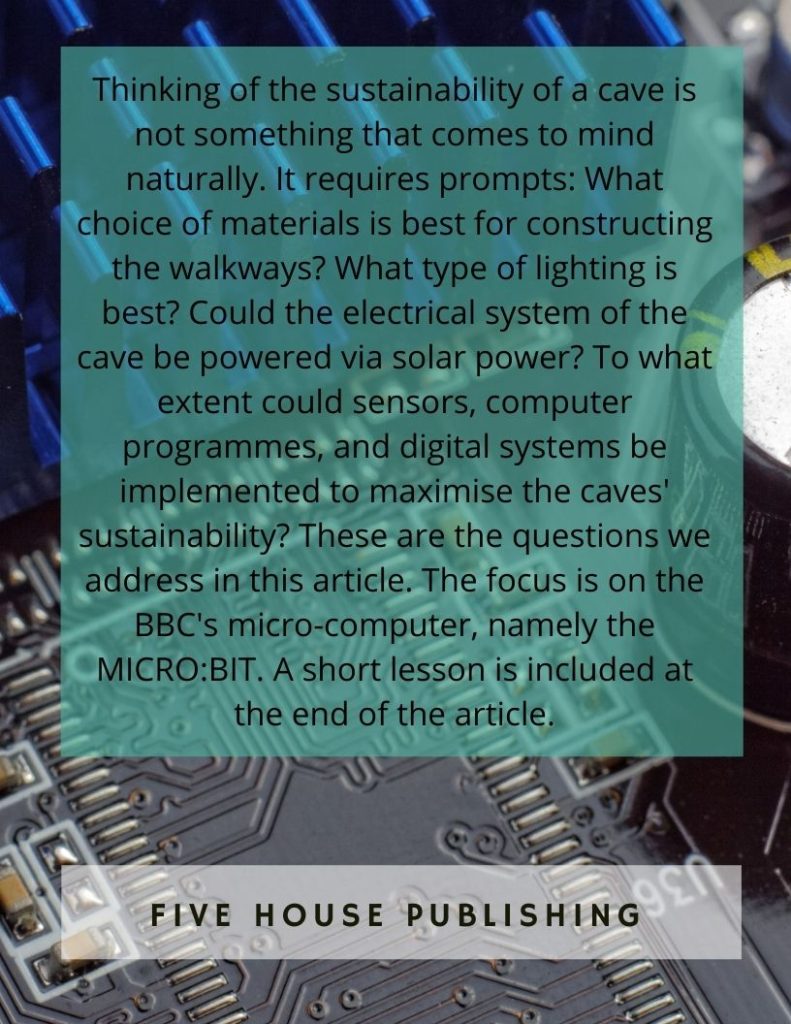
By William Van Zyl
Thinking of the sustainability of a cave is not something that comes to mind naturally. It requires prompts: What choice of materials is best for constructing the walkways? What type of lighting is best? Could the electrical system of the cave be powered via solar power? To what extent could sensors, computer programmes, and digital systems be implemented to maximise the caves’ sustainability? These are the questions we address in this article. The focus is on the BBC’s micro-computer, namely the MICRO:BIT. A short lesson is included at the end of the article.
Do you think digital technology, like sensors and micro-computers, could help protect limestone caves’ sensitive ecosystems? If your answer is yes, this article will support your conviction. However, if you don’t have knowledge of modern technology and the many possibilities, this article is also for you. It is written in straightforward terms so anyone interested will understand the ideas, concepts and designs. If you are a student or a teacher, this article includes an excellent opportunity for learning new things. Teachers could use this resource to produce a unique lesson on digital technology and sustainability! A is lesson is included at the end of the article.
Contents
Considering the construction materials for the walkways: 7
‘Do your bit’ challenge (Micro:bit – microprocessor/pocket computer). 7
Life on Land: Sustainable Development Goals 15 (United Nations). 9
Here is a diagram of the Micro:bit with annotations: 10
The mBot Buggy from Makeblock. 10
GIS and Karstic Cave Monitoring. 14
Ever wondered what the average temperatures in caves are?. 15
Engineer Hamish Trolove from Wellington, New Zealand (ABOUT HAMISH). 15
How does the ultrasonic range finder of the mBot works?. 16
Let’s test its sensitivity. 17
How could the other sensors of the mBot be utilised in the caves to improve sustainability?. 18
What about the sensors of the Micro:bit? Could the Micro:bit be used to sense changes in a cave?. 18
The challenge to students: The application of the sensors in the caves. 23
Copyright © 2021 by William Van Zyl 25
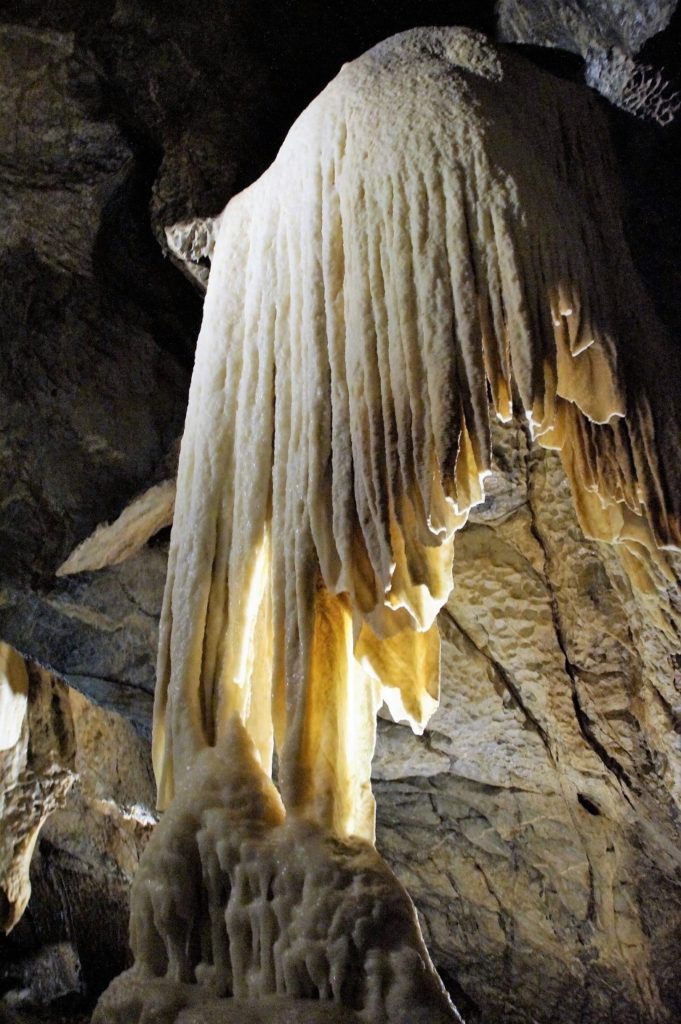
Typical limestone cave formations: Beautiful curtain or drapes (stalactites) hanging from the cave’s roof formed over hundreds of years in a limestone cave’s wet conditions. The question is, what role could technology play in protecting these caves so future generations could enjoy these spectacular cave features? Could the sensors of a Micro:bit or a mBot contribute to keeping the equilibrium of the biodiversity stable? What do you think? Any ideas?
Table of Contents
Materials and components:

Diagram: Sectional view of a walkway in the Waitomo Caves (NZ). Freehand sketch by the author. Material choices: Galvanised steel, stainless steel, galvanised mesh, galvanised rods & epoxy (glue). Lighting choices: LED lighting. Sensors: Oxygen, CO2, temperature & ultrasonic. Can you think of any other sensors that could make a difference in the ecology of a cave? What is ecology? Ecology is the study of the relationships between living organisms, including humans, and their physical environment; it seeks to understand the vital connections between plants and animals and their world. Credit sketch: W. Van Zyl.
Considering the construction materials for the walkways:
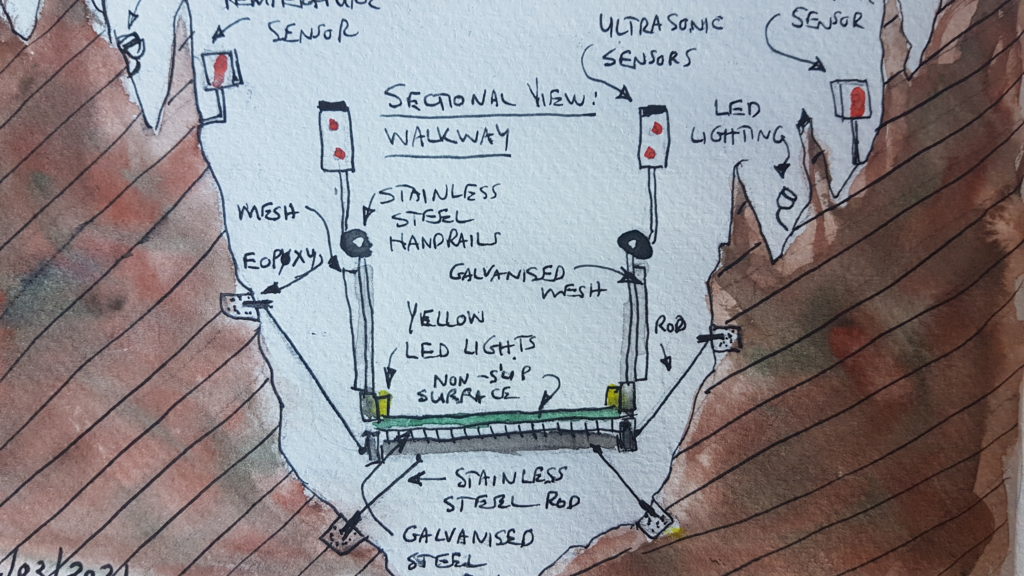
Close up of the walkway. See the different materials of the suspended walkway/bridge. Stainless steel handrails, galvanised mesh and grid, Galvanised rod epoxied (special glue used) into the rock face, and a plastic non-slip surface laid onto the walkway floor (green colour). Credit: W Van Zyl.
‘Do your bit’ challenge (Micro:bit – microprocessor/pocket computer)
The ‘do your bit’ challenge – using digital technology to solve real-life problems – has been very popular. In my previous article, I have explained and explored the Waitomo Caves’ sustainability in New Zealand. I have mentioned the role of sensors in the caves. The BBC Micro:bit V2 (newestr version) is an excellent microprocessor which could be used to implement and design sensors to help manage the limestone caves’ sustainability. In this article, the focus is also on an alternative electronic gadget, namely the mBot buggy. The mBot has several sensors. More about the mBot later.
Visit the do your bit website to see more about the challenge: https://microbit.org/projects/do-your-bit/
This article builds on the first article by the author. Here is the link to the previous article by the Author:
Entering a Dark, Humid Cave – lit up by cat-eyed, yellow fiery flies – could turn your thinking upside down – https://fivehousepublishing.com/2021/03/20/entering-a-dark-humid-cave-lit-up-by-cat-eyed-yellow-fiery-flies-could-turn-your-thinking-upside-down/
Here is an excerpt from the article:
On Friday, 5 March 2021, I stepped into the unknown. It was dark, humid, and very black. Yellow cat-eyes stared at me from the ground. It was evenly spaced and extended way ahead of me. Where could it lead? It took some time for my sensitive eyes to adapt to the lack of light.
The tiny yellow eerie lights led the way – into the unknown.
The handrails were dead-cold and wet. My cold, wet hands slipped away from the cold stainless steel. It must have cost a small fortune to install all these stainless steel handrails, I thought. I know all types of metal. This was definitely stainless steel. Tiny grooves have been added in an attempt to reduce the slippery surface of the rail in always wet conditions.
The guide stopped and waited till the group all gathered around him. His headlight was pointing up. It looked like a halo. I looked up. Pointy stalactites hanged dangerously low from the roof of the cave.
“Don’t touch the limestone. The natural chemicals on your hands will affect it,“ said the guide. I instinctively pulled my hand back. “There is a $ 10,000 fine in place to protect all the precious stalactites and stalagmites,” said the guide with a friendly smile.
The guide’s light, some 15 meters ahead of me, skimmed over some more interesting formations. It looked like wax, white candle wax. There was a unique curtain formation – a beautiful limestone drape.
The headlight of the guide went down, right down. It seemed like the earth was opening its mouth. Cracks and crevasses extended into the abyss. Then I noticed the walkway was suspended several meters above the large rocks. I felt unsafe. I stopped and placed my hands on the handrail; I then knelt down and touched the walkway’s different parts and components. The structure was a combination of other materials. Stainless steel rods – diameter of about 20 mm – was anchored into the rocks and was connected to the walkway bridge. It looked like spider web chords holding the ‘fairy bridge in position. The floor was a strong galvanised metal grid with a recyclable rough layer of plastic on top of it. It was very rough. The footing was very well designed to prevent any slipping while walking on the walkway bridges. The wet conditions in the caves required secure footings. Safety in a cave is paramount. The sides of the bridges and walkways were covered with galvanised steel mesh with a diameter of about 6 mm to 8 mm. The construction was solid and rustproof…
Let’s continue with the sensors.
Life on Land: Sustainable Development Goals 15 (United Nations)
Let’s look at the wording of the 15 th Goal, namely “Life on land.” The official language is: “Protect, restore and promote sustainable use of terrestrial ecosystems, sustainably manage forests, combat desertification, and halt and reverse land degradation and halt biodiversity loss”. The Goal has 12 targets to be achieved by 2030. Progress towards targets will be measured by 14 indicators. The sensors of the Micro:bit or mBot (Makerbot) can be used in managing the sustainability of a cave, which is the focus of this article. The SDG goal (No 15) is integrated into this article an consequently into the lesson plan and idea. Let’s start with the outline of the lesson.
Learning Intention:
1. Define digital sensors: ‘Exploring the sensor functions and possibilities of a Micro:bit and the MBot.’
2. Investigate SDG 15: ‘Life on Land’ regarding sustainable practices for limestone caves (any limestone cave around the world). This article focuses on the Waitomo Caves in New Zealand. However, from a global citizenship position, students could investigate the limestone caves in their own country. There are thousands of limestone caves around the world.
Here is a diagram of the Micro:bit with annotations:

New BBC Micro:bit V2 with Built-In Speaker, Microphone and Touch Sensor. With five million BBC Micro:bits in use for learning digital skills and computational thinking, the revamped Micro:bit will provide even more opportunities for young engineers. The Micro:bit V2 will be available at the same price point in November 2020. Credit: https://www.elektormagazine.com/news/new-bbc-microbit-v2-speaker-microphone-touch-sensor
The mBot Buggy from Makeblock
Alternatively, the mBot (Makeblock) buggy is the next step after introducing the Micro:bit. The buggy has a remote control unit which makes the buggy more versatile; this provides a fun component for students. The Bluetooth capability allows students to control the buggy via their mobile phones. This elevates enjoyment of the programmable RC buggy. See the diagram of the mBot for the different functions available.

Credit image: https://hiphomeschoolmoms.com/lightning-deal-alert-makeblock-mbot-robot-kit-50-off/

The versatile mBoT: 3-D EXPLODED VIEW OF THE DIFFERENT PARTS AND COMPONENTS. From the outset, mBot, with its big adorable eyes and cute smiley face, has enthralled more than 4.5 million children worldwide. mBot is an educational playmate for children learning to build and program. It is an excellent educational aid for teachers for STEAM lessons. It is also a frequent heavyweight contender at large robot competitions, such as MakeX. mBot gets children to engage both their hands and their brain, encouraging them to exercise their interdisciplinary abilities while allowing them to experience the endless fun of creation at the same time. Credit: https://www.makeblock.com/steam-kits/mbot
A robot will have a tough time if it cannot sense the world around it. The mBot has several sensors already on-board, which help it respond to things it might encounter as it moves around.
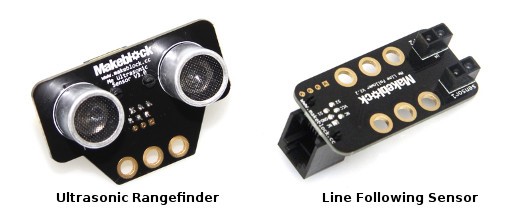
On the mBot mainboard, there are Light Sensors, an Infrared Receiver and Infrared Transmitter for communication between mBots and for receiving signals from the infrared remote.
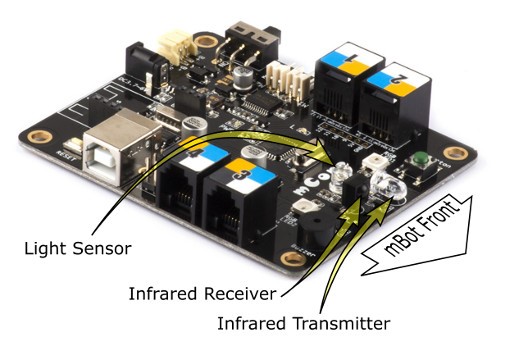
In the mBlock interface, there are code blocks that match each type of sensor in the standard mBot kit and extra sensors and devices that can be added. Credit images: http://www.techmonkeybusiness.com/robotics-1d-mbot-sensors.html
Credit Author: Hamish Trolove, Category: Tutorials
Tags : mBot / Robotics / (CC BY-SA 4.0)
Now that we have an overview of the different sensors of the Micro:bit microprocessor and the robot (mBot). How could the sensors be used in the cave to provide data to the managers of the caves? Let’s investigate? The crucial aspects that have to stay stable are:
- Temperature
- Humidity
- Oxygen and CO2 levels
GIS and Karstic Cave Monitoring
Karstic, or limestone, caves are potentially an important source of information for paleoclimate data and provide perhaps the most accurate terrestrial climate information relative to all other data sources. Furthermore, they play an essential role in the hydrologic cycle and act as global warming pollution traps. Monitoring, therefore, has become important of karst formation, including the number of speleothemes, which are stalactites and stalagmites, present in these caves and what happens to them over time. Water and gas exchanges, particularly CO2, are important processes that affect caves and modern and ancient climate and hydrologic conditions. Monitoring techniques have now allowed cave management to become a rapidly growing area of study for understanding modern and ancient environmental change. The monitoring of these caves reveals data that are crucial to understanding climate change.
Source: https://www.gislounge.com/gis-karstic-cave-monitoring/
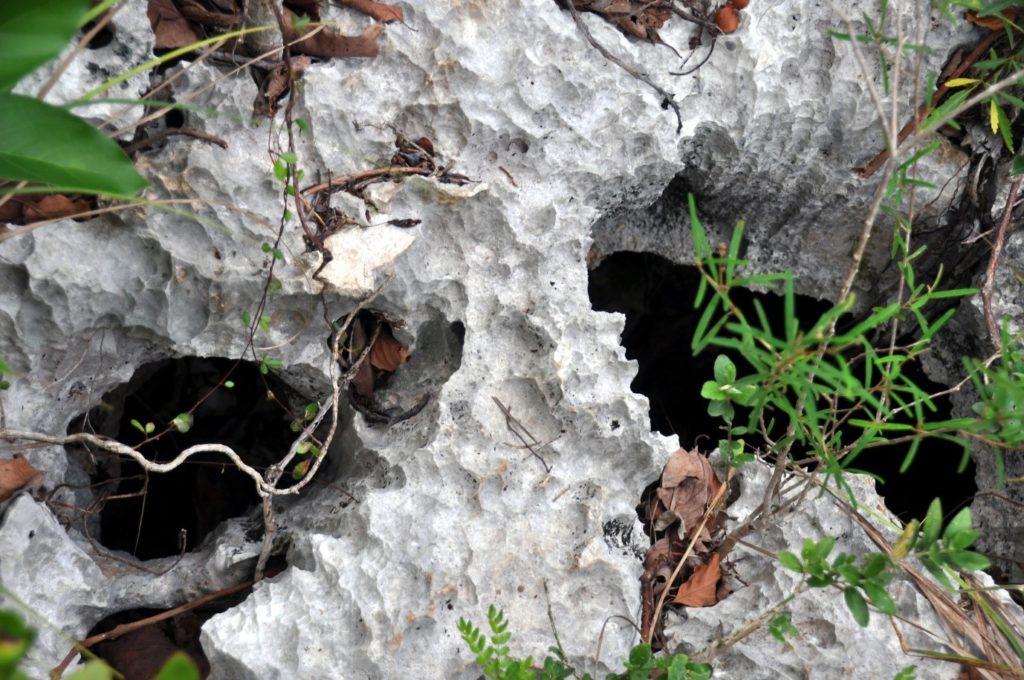
IMAGE: Garden Cave – karst windows (San Salvador Island, Bahamas):
ABOUT THE IMAGE: EASTERN BAHAMAS
Window (skylight) over Garden Cave, located near the hilltop south of Reckley Hill Pond & north of the eastern end of Crescent Pond, northeastern San Salvador Island, eastern Bahamas.
Garden Cave is hosted in a lithified sand dune ridge composed of aragonitic calcarenite limestones of the Owl’s Hole Formation (Middle Pleistocene). This cave is a partially collapsed flank margin cave. Flank margin caves form at the flanks of carbonate islands and at the margins of fresh-groundwater lenses. As such, flank margin caves are phreatic features. In the vicinity of the seawater-freshwater mixing zone (halocline) of a groundwater lens (see diagram – www.carbonatecreek.com/caves/images/carbisland.gif), relatively rapid dissolution of limestone occurs due to the high aggressivity of the water. Limestone dissolution at Garden Cave occurred during the Middle Pleistocene and/or Late Pleistocene.
Flank margin caves have no surface entrances. Access to them occurs only after surficial erosion intercepts chambers or passages. Garden Cave is an erosional remnant of a larger flank margin cave. Much of the remaining cave has large to small ceiling collapses, resulting in windows (a.k.a. skylights) – subvertical conduits and openings between the land surface and cave passages or rooms. The cave is now partially filled with fine-grained sediments, limestone rubble, and soil.
Credit image: Flickr. James St. John
Ever wondered what the average temperatures in caves are?
Caves in the US:
A cave’s temperature is usually close to the average annual temperature for the region where it’s located. For example, caves in Texas can be as warm as 21º C. Caves in Missouri might be between 12.7º C and 15.5º C. Caves in Wisconsin might be a chilly 10º C.
Temperature in the Waitomo Caves in New Zealand:
Inside the caves is a steady 12-14°C year-round.
What are the temperatures of the limestone caves (or other caves) in your country?
Engineer Hamish Trolove from Wellington, New Zealand (ABOUT HAMISH)
‘By training and by inclination, I am an engineer. It probably shows. I am fascinated by things that move and do stuff. For this reason, I play around with making all kinds of mechanical constructions for amusement. I am also creative. This, together with my technical background, makes for an interesting combination that yields things like teapots mounted on rails, large scale models of the solar system, and many other things. Of course, as a true creative, I am great at starting things but slightly less good at finishing them.’ Hamish Trolove.
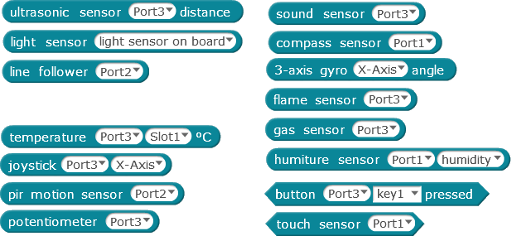
Sensor INTERFACE mBot: You will notice that these blocks are all designed to fit where you would put a number in the Scratch operators and control blocks. This means they can be used directly to control program loops, motor speeds, and anywhere else where you might use a number. Credit Author: Hamish Trolove
How does the ultrasonic range finder of the mBot works?
The ultrasonic range finder works by sending out pulses of sound at a very high frequency. The sound bounces off objects and returns to the sensor as an echo. The sensor measures the time between sending the pulse and hearing the echo. Because the sensor knows that the speed of sound is 340m/s, it can calculate the distance to the object that a sound wave reflects off and report that to the mBot. It is using echolocation in much the same way a bat does.
The sound emitted by the sensor is 40khz. This is too high for us to hear. Our hearing range is typically between 20Hz and 20kHz. A dog could hear it because a dog can hear up to 45kHz. A bat could also hear it because they can hear up to 200kHz. Would it confuse a bat?
The Manufacturers Specifications state that the sensor can do the following;
It has a measurement resolution of 10mm.
It has an angle over which it can detect things of 15°
And it can measure distances between 2cm and 4m
The reading from the sensor is in centimetres.
Let’s test its sensitivity.
Here are some simple tests to try with this arrangement. The 4-digit display will show the distance in cm to the object the mBot is detecting.
How far away and how close does it detect distances? You may need to point it at a wall to measure longer distances. How does that match the manufacturer’s specifications?
What is the measurement resolution? Measure how much the sensor reading changes if you move something towards it by 10cm, 20mm, 10mm, and 5mm?
How big does the object need to be before it can be detected?
Are there shapes it has trouble with?
What is the angle of view over which the mBot can detect things?
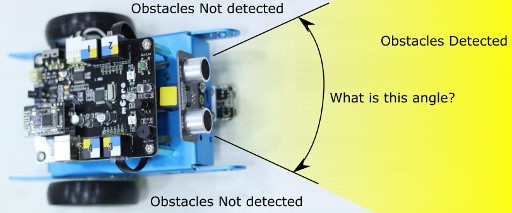
Credit diagram: Credit: Hamish Trolove
The question now is: How could this ultrasonic range finder (sensor) be used in a cave environment to improve sustainability? Here is a possible application: In the Waitomo Caves – where the stalactites are close to the walkways – visitors can reach out and touch the formations. These actions could have a detrimental effect on the stalactites (chemicals from human hands contaminating the formations). The ultrasonic sensor of the mBot could be used to warn visitors if they get too close to the stalactites (illegally reaching out to touch the limestone). For example, an alarm could go off– using the ultrasonic sensor technology of the mBot – to manage the caves. The loud beep acts as a deterrent. This is a possible solution to eliminate the touching of the stalactites and stalagmites while visitors are moving through the caves.
Source – link to Tech Monkey Business (Hamish Trolove): http://www.techmonkeybusiness.com/robotics-1d-mbot-sensors.html
How could the other sensors of the mBot be utilised in the caves to improve sustainability?
The light sensor: Switching lights on and off in the caves as the guide’s headlight shines on the sensor? Could this feature be combined with timers? For example, as the guide with his group of visitors exits an area in the cave it, could switch off the Led lights automatically.
What about the infrared sensor? Could you think of an application?
What about the line following sensor (light sensor)? Any ideas for a cave environment?
What about the sensors of the Micro:bit? Could the Micro:bit be used to sense changes in a cave?
There are several sensors available from the Microbit.
The Micro:bit can sense movement, light, temperature and magnetic fields.
Let’s look at the sensors in detail. Here are screenshots from the Micro:bit website (https://microbit.org/get-started/first-steps/sensors/) to explain the different sensors. Visit the website to see the working of the sensors in detail. For this article, we are looking at the application of these sensors in a cave context. Here are short videos of the different sensors of the Micro:bit.

Set 2: The Accelerometer








Credit Micro:bit images: https://microbit.org/get-started/first-steps/sensors/ Visit the website to learn more!
Here is a cool trick you can create with the light sensor of the Micro:bit.
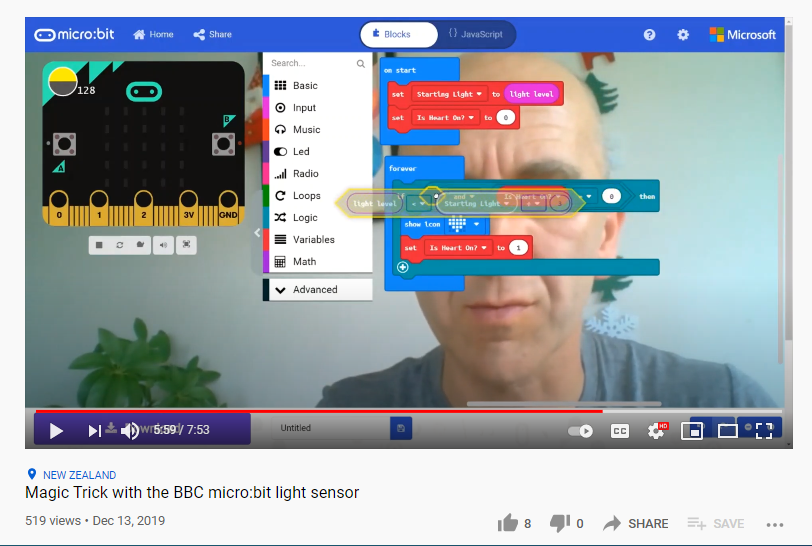
Here is a great video that explains the light sensor of the Micro:bit: The MakerCode Hardware.
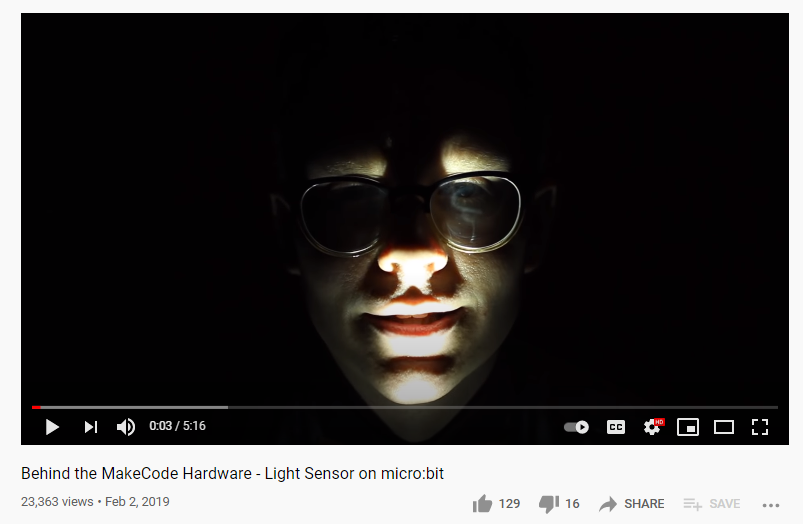
With all the new knowledge it is your turn to explore and investigate possible applications of the mBot and the Micro:bit in a cave context.
LESSON PLAN: Application of a microprocessor (Micro:bit) to maintain the eco-equilibrium in a limestone cave-system. Focus on sensors.
Do now: Identify all the different sensor possibilities of the Micro:bit and /or the mBot?
The challenge to students: The application of the sensors in the caves.
The challenge now is to consider the Micro:bit sensors and how they could be implemented in the Waitomo Caves (or other caves). For instance, how to improve and manage sustainability in the Waitomo caves (or any other cave). Use these concepts and components as a guide.
- Monitoring the temperature in the caves
- Accelerometer (detecting movement)
- Light sensor (detecting day and night time)
- Touch sensor (touch switch controlling the lights in the caves – on/off – timers)
- Compass bearing (could provide compass bearing in the caves). Will the Micro:bit’s compass work underground? Find out how the compass works before attempting to answer this question?
- In groups or in pairs, brainstorm and discuss the possible applications of the technology discussed in this article.
Learning intention:
- To learn about the ecosystems in caves
- To learn about the different sensor components of the Micro:bit and mBot (or Raspberry Pi/Arduino Uno)
- To learn how to apply the knowledge of sensors in a cave context with a focus on sustainability (monitor and manage).
- To learn about the effect and impact these sensors could have in detecting change. How to maintain the optimum equilibrium in the caves? Remember the focus is on sustainable practice.
ACTIVITY 1: Identify the different sensors of the Micro:bit? Make a diagrammatic sketch with annotations of the Micro:bit?
ACTIVITY 2: Identify all the different aspects that influence the ecosystem in a cave? Explain in short how it all works together to maintain the balance of the cave-system?
ACTIVITY 3: Explore how the Micro:bit could work to detect changes in the cave-system? Explain the detection capabilities of the sensors briefly?
ACTIVITY 4: Practical. Program the Micro:bit using simple electrical diagrams and code to illustrate the different sensor capabilities? Make simple diagrammatic sketches and paste the code into a Google Doc. Share with the teacher.
ACTIVITY 5: If you have a Micro:bit or mBot, create a cave sensor of your choice. Test it in a dark room. Type up a short review of your findings. Illustrate and communicate your design with diagrams and photos. Share with the teacher and the class.
PRESENTATION OF STUDENT WORK: GOOGLE DOC SHARED WITH THE TEACHER
- Photographs (phone photos are fine) pasted into a Google Doc. Shared with the teacher.
- Diagrams with annotations (pencil, pen and watercolours) – Google Doc.
- Micro:bit/mBot computing code: Pasted code into the Google Doc. Screenshots are fine.
- A short summary of the system. Typed up with a heading for a sensor.
- Explain how the sensors will improve the cave-system’s sustainability? In other words, how the Micro:bit will detect and warn of any changes in the caves. For example, the increase of CO2 levels as humans move through the caves with a guide.
- OPTIONAL – Bigger picture question (advanced): How does caves contribute to climate change and sustainability in general on a global scale?
- ADVANCED (optional) – How will the power supply get from the surface (outside the cave) to the inside to provide power to the sensors. Think about saving power. Think about solar panels and more.
- ADVANCED (optional) – How will the sensors communicate with the computers on the surface (an office somewhere outside the caves)? Tiny cables? Bluetooth maybe? By the way, just want to mention that a large hole was drilled (Waitomo Caves, NZ) which the construction workers used to transport concrete, materials, and equipment while creating the walkways and infrastructure inside the caves. Drill holes for the cables?
Download the full story and review of the Ruakuri cave construction:
*RUAKURI CAVES Martin Hansen and Tanya Wylie
Listen to the podcast of this article:
https://www.podbean.com/ew/pb-qdbxk-ffd5fb
Copyright © 2021 by William Van Zyl
Sensors: Maintaining the eco-equilibrium of sensitive limestone caves in New Zealand. STEM and Digital Technologies -Programming microprocessors as sensors to improve cave sustainability (Micro:bit and Makerbot – mBot).
All rights reserved. This article/eBook or any portion
thereof may not be reproduced or used in any manner
whatsoever without the express written permission of the
publisher except for the use of brief quotations in a book review.
Published by Five House Publishing (New Zealand)
First Publishing, 2021
About the Author:
The author had an exciting and unique childhood. Not as you would expect – not travelling abroad – but venturing through the fields, bushes, tools sheds, and mysterious underground tunnels around his neighbourhood. His happy place was – and still is – tinkering with ideas, science, and new possibilities. While cycling, he will often get new ideas; he brings the unexpected, the unique, and creative flurry on a page or a sketch. To this day, he dreams of vicious wars and sophisticated weaponry in an innocent child’s scout cave. He loves diagrams, timelines, cross-sections, sketches, and details of sinister and hidden concepts and ideas, always looking for a new mystery to decode and encode. He investigates and explores extravagant thoughts that he includes in children’s books and stories; he loves to portray philosophers’ perspectives, articles, intriguing stories, and poetry. Academic and research work are his forte. He always offers a practical but straightforward explanation within an engaging context. Not your ordinary thinker! A lifelong scholar and teacher.
More articles, eBooks, lessons and resources available to teachers and students at Five House Publishing.

Download PDF: https://fivehousepublishing.com/
More about the author: http://williamvanzyl.com/
Or, visit the blog: https://fivehousepublishing.com/blog/